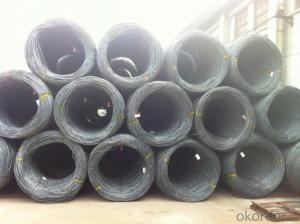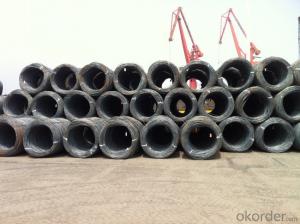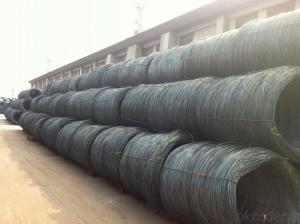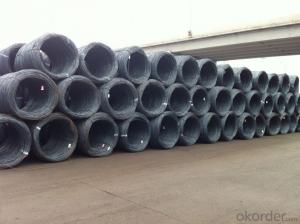Hot Rolled Wire Rods with SAE 1008 in Best Quality
- Loading Port:
- Tianjin
- Payment Terms:
- TT OR LC
- Min Order Qty:
- 25 m.t.
- Supply Capability:
- 10000 m.t./month
OKorder Service Pledge
OKorder Financial Service
You Might Also Like
Product Description:
OKorder is offering Carbon Steel Wire Rod at great prices with worldwide shipping. Our supplier is a world-class manufacturer of steel, with our products utilized the world over. OKorder annually supplies products to European, North American and Asian markets. We provide quotations within 24 hours of receiving an inquiry and guarantee competitive prices.
Product Applications:
Carbon Steel Wire Rod are ideal for structural applications and are widely used in the construction of buildings and bridges, and the manufacturing, petrochemical, and transportation industries.After hot-rolled the products shaped into coil and delivery as finished product, including round, square, rectangular, hexagonal and so on. Since most of the products are round, it is generally called wire rod. Carbon steel wire rod is widely used in construction and manufacturing. Carbon steel wire rod is mainly used for reinforcement of reinforced concrete and welded structure or reprocessed (roberts , nail, etc.) materials, especially used to produce wire drawing, welding electrode, nails, spring, electronic, precise machinery parts and so on.
Product Advantages:
OKorder's Carbon Steel Wire Rod are durable, strong, and resist corrosion.
Main Product Features:
· Premium quality
· Prompt delivery & seaworthy packing (30 days after receiving deposit)
· Corrosion resistance
· Can be recycled and reused
· Mill test certification
· Professional Service
· Competitive pricing
Product Specifications:
Chemical Composition:
Please kindly find our chemistry of our material based on SAE1006/SAE1008 as below for your information
Grade | Chemical Composition (%) | |||||
C | Mn | S | P | Si | B | |
SAE1006B | 0.03~O.07 | 0.32max | 0.045max | 0.040max | 0.30max | 0.0008min |
Mechanical properties | ||||||
Yield strength(N/mm2) | Tensile strength(N/mm2) | Elongation (%) | ||||
250-280 | 350-380 | ≥32 | ||||
Grade | Chemical Composition (%) | |||||
C | Mn | S | P | Si | B | |
SAE1008B | 0.10max | 0.3~0.50 | 0.050max | 0.040 max | 0.15max | 0.0008 min |
Mechanical properties | ||||||
Yield strength(N/mm2) | Tensile strength(N/mm2) | Elongation (%) | ||||
≥195 | 315-430 | ≥30 | ||||
FAQ:
Q1: Why buy Materials & Equipment from OKorder.com?
A1: All products offered by OKorder.com are carefully selected from China's most reliable manufacturing enterprises. Through its ISO certifications, OKorder.com adheres to the highest standards and a commitment to supply chain safety and customer satisfaction.
Q2: How do we guarantee the quality of our products?
A2: We have established an advanced quality management system which conducts strict quality tests at every step, from raw materials to the final product. At the same time, we provide extensive follow-up service assurances as required.
Q3: How soon we can delivery the goods ?
A3: We have a mill with 20000mts of capacity per month. We can delivery the goods within in one month ,as long as your order quantity less than 20000mts
Image

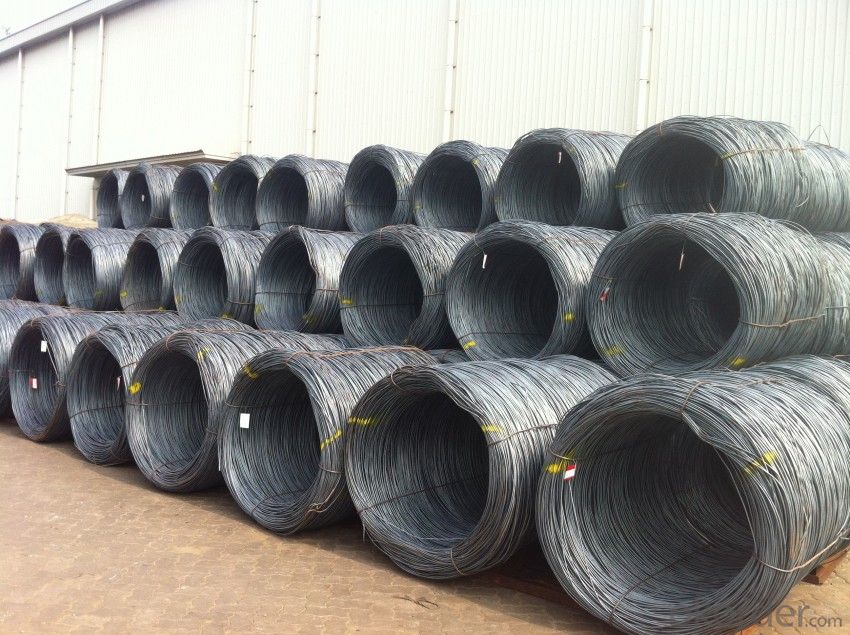
- Q:What are the different types of steel wire rod coating materials?
- There are various types of steel wire rod coating materials available, including zinc, copper, aluminum, and polymer coatings. These coatings provide different levels of protection against corrosion and improve the wire's durability and longevity. Each coating material is chosen based on its specific properties and the intended use of the wire rod.
- Q:How does the recycling process affect the mechanical properties of steel wire rod?
- The recycling process of steel wire rod can have both positive and negative effects on its mechanical properties. One of the main advantages of recycling steel wire rod is that it helps conserve natural resources and reduce the overall carbon footprint of the steel industry. By using scrap steel as a raw material, the recycling process can save energy and reduce emissions associated with mining and processing iron ore. This conservation of resources and reduction in energy consumption can indirectly contribute to the mechanical properties of the recycled steel wire rod. However, the recycling process can also introduce impurities and alloying elements that may affect the mechanical properties of the steel wire rod. During the melting and refining stages of the recycling process, impurities such as sulfur, phosphorous, and non-metallic inclusions can be introduced into the steel composition. These impurities can have adverse effects on the mechanical properties, such as reducing ductility, toughness, and fatigue strength. In addition, the recycling process may also lead to changes in the microstructure of the steel wire rod. The repeated heating and cooling cycles during melting, casting, and rolling can alter the grain size, grain boundaries, and phase distribution within the steel. These changes can impact the mechanical properties of the steel wire rod, such as its hardness, tensile strength, and elongation. To mitigate the potential negative effects of the recycling process on the mechanical properties of steel wire rod, various techniques and processes can be implemented. For instance, advanced refining methods can be employed to reduce impurities and control the chemical composition of the recycled steel. Additionally, heat treatment processes can be used to optimize the microstructure and improve the mechanical properties of the steel wire rod. Overall, while the recycling process of steel wire rod has the potential to impact its mechanical properties, with proper quality control measures and optimization techniques, the recycled steel can still meet the required mechanical specifications for various applications.
- Q:What are the different fatigue testing methods for steel wire rod?
- There are several fatigue testing methods that can be used to evaluate the fatigue strength and performance of steel wire rods. These methods include: 1. Rotating Bending Fatigue Test: This method involves subjecting the steel wire rod to a rotating bending load, which simulates the cyclic loading conditions that the rod may experience in real-world applications. The test is typically conducted by applying a constant load while rotating the rod at a specified speed. The number of cycles to failure is recorded to determine the fatigue strength of the wire rod. 2. Axial Fatigue Test: In this method, the steel wire rod is subjected to an axial load that is applied in a cyclic manner. The load is typically applied using a hydraulic or servo-hydraulic testing machine, and the number of cycles to failure is recorded. This test method is particularly useful for evaluating the fatigue performance of steel wire rods used in tension applications, such as suspension cables. 3. Torsional Fatigue Test: This method involves subjecting the steel wire rod to a cyclic torsional load, which simulates the twisting forces that the rod may experience in certain applications. The test is typically conducted by applying a constant torque while rotating the rod at a specified speed. The number of cycles to failure is recorded to assess the fatigue strength of the wire rod under torsional loading conditions. 4. Combined Loading Fatigue Test: This method involves subjecting the steel wire rod to a combination of different loading types, such as axial, bending, and torsional loads, to simulate the complex loading conditions that the rod may encounter in real-world applications. The test is typically conducted by applying cyclic loading in multiple directions simultaneously or sequentially. The number of cycles to failure is recorded to evaluate the fatigue performance of the wire rod under combined loading conditions. It is important to note that the selection of the appropriate fatigue testing method for steel wire rod depends on the specific application and loading conditions that the rod will be subjected to. The chosen testing method should closely replicate the actual loading conditions to obtain accurate and reliable fatigue strength data for the wire rod.
- Q:How is steel wire rod used in the manufacturing of wire for reinforced concrete structures?
- Steel wire rod is an essential component in the manufacturing of wire for reinforced concrete structures because it serves as the raw material for producing the wire. The rod is first drawn through a series of dies to reduce its diameter, creating the desired wire thickness. This wire is then further processed and treated to enhance its strength and durability. Finally, the wire is bundled and used to reinforce concrete structures, such as beams, columns, and slabs, providing tensile strength and improving the overall structural integrity.
- Q:How does the chemical composition of steel wire rod affect its properties?
- The chemical composition of steel wire rod significantly affects its properties. The presence and quantity of various elements, such as carbon, manganese, silicon, and others, determine the steel's strength, hardness, ductility, and other mechanical properties. These elements can also impact the steel's resistance to corrosion, heat, and wear. Additionally, the chemical composition influences the steel's ability to be formed, welded, and machined. Therefore, selecting the appropriate chemical composition is crucial in determining the desired properties and performance of steel wire rod.
- Q:What are the main factors influencing the choice of steel wire rod order tracking system?
- Several key factors influence the selection of a steel wire rod order tracking system. To begin with, the size and complexity of the system are important considerations. If the company deals with a large number of orders, it may require a more advanced and sophisticated tracking system to efficiently manage and track them. Conversely, if the company has fewer orders, a simpler system may suffice. Additionally, the specific requirements and needs of the company play a crucial role in determining the choice of order tracking system. Each company may have different priorities and objectives, such as reducing lead times, improving accuracy, or enhancing customer satisfaction. The chosen system should align with these goals and effectively address the company's unique needs. Integration and compatibility with existing systems and processes are also significant factors. The order tracking system should seamlessly integrate with other systems and processes within the company, such as inventory management, production planning, and customer relationship management. This ensures smooth operations and avoids any disruption or duplication of efforts. Furthermore, the order tracking system should be scalable and flexible. As the company grows and expands, the system should be able to accommodate increasing order volumes and changing requirements. It should be easily adaptable to meet the evolving needs of the business. Cost and return on investment are important considerations as well. The system should provide value for money by improving efficiency, reducing errors, and enhancing customer satisfaction. The upfront and ongoing costs of implementing and maintaining the system should be assessed and weighed against the potential benefits. Lastly, the availability of technical support and training is crucial. The chosen tracking system should be supported by a reliable and responsive technical support team, capable of promptly addressing any issues or concerns. Additionally, comprehensive training and documentation should be provided to ensure that the company's employees can effectively utilize and maximize the benefits of the system. In conclusion, the choice of a steel wire rod order tracking system is influenced by various factors, including the size and complexity of the system, specific requirements and needs of the company, integration and compatibility with existing systems, scalability and flexibility, cost and return on investment, and availability of technical support and training. By considering these factors, a company can make an informed decision and select the most suitable order tracking system for their operations.
- Q:What are the trends in the steel wire rod market?
- The trends in the steel wire rod market include increased demand due to infrastructure development, automotive industry growth, and the rising popularity of steel wire rods in construction and manufacturing sectors. Additionally, there is a shift towards the production of high-quality and technologically advanced steel wire rods, as well as a focus on sustainability and environmental regulations.
- Q:What are the environmental impacts of producing steel wire rod?
- The production of steel wire rod can have various environmental impacts, both during the extraction of raw materials and the manufacturing process. Here are some of the key environmental impacts associated with producing steel wire rod: 1. Resource extraction: Steel wire rod is primarily made from iron ore, which requires extensive mining activities. These mining operations can lead to deforestation, habitat destruction, and soil erosion. Furthermore, the extraction and transportation of iron ore contributes to greenhouse gas emissions and air pollution. 2. Energy consumption: The production of steel wire rod involves several energy-intensive processes, such as smelting, refining, and shaping. These processes typically rely on fossil fuels, such as coal and natural gas, which release large amounts of carbon dioxide into the atmosphere. High energy consumption not only contributes to climate change but also depletes non-renewable resources. 3. Air and water pollution: The manufacturing process for steel wire rod can release various pollutants into the air and water. During smelting, emissions of sulfur dioxide, nitrogen oxides, and particulate matter can contribute to air pollution and acid rain. Water pollution can occur through the discharge of wastewater containing heavy metals, oil, and chemicals used in the production process, potentially contaminating nearby water bodies. 4. Waste generation: Steel wire rod production generates significant amounts of waste materials, including slag, dust, and sludge. These waste products often contain harmful substances, such as heavy metals and toxic chemicals, which can pollute the environment if not properly managed. Waste disposal can also contribute to land degradation and the depletion of natural resources. 5. Carbon emissions: Steel production, including the production of wire rod, is a major contributor to global carbon emissions. The high temperatures required to convert iron ore into steel result in the release of large amounts of carbon dioxide. Additionally, the use of fossil fuels in the manufacturing process further adds to the carbon footprint of steel wire rod production. To mitigate these environmental impacts, the steel industry has been adopting various measures such as implementing cleaner technologies, improving energy efficiency, and reducing reliance on fossil fuels. Additionally, recycling steel scrap can significantly reduce the environmental burden associated with steel wire rod production.
- Q:What are the different weldability testing methods for steel wire rod?
- There are several different weldability testing methods for steel wire rod. These include the macroscopic examination, which involves visually inspecting the weld for any defects or anomalies; the bend test, where the weld is bent to evaluate its ductility and resistance to cracking; the tensile test, which measures the strength and elongation of the weld; the hardness test, which determines the hardness of the weld and its susceptibility to cracking; and the impact test, which assesses the weld's ability to withstand sudden loads and impacts.
- Q:What are the common recycling methods for steel wire rod?
- Some common recycling methods for steel wire rod include melting and remolding the steel into new wire rod, using it as a raw material for manufacturing other steel products, or repurposing it for construction materials.
1. Manufacturer Overview |
|
|---|---|
| Location | |
| Year Established | |
| Annual Output Value | |
| Main Markets | |
| Company Certifications | |
2. Manufacturer Certificates |
|
|---|---|
| a) Certification Name | |
| Range | |
| Reference | |
| Validity Period | |
3. Manufacturer Capability |
|
|---|---|
| a)Trade Capacity | |
| Nearest Port | |
| Export Percentage | |
| No.of Employees in Trade Department | |
| Language Spoken: | |
| b)Factory Information | |
| Factory Size: | |
| No. of Production Lines | |
| Contract Manufacturing | |
| Product Price Range | |
Send your message to us
Hot Rolled Wire Rods with SAE 1008 in Best Quality
- Loading Port:
- Tianjin
- Payment Terms:
- TT OR LC
- Min Order Qty:
- 25 m.t.
- Supply Capability:
- 10000 m.t./month
OKorder Service Pledge
OKorder Financial Service
Similar products
New products
Hot products
Related keywords
